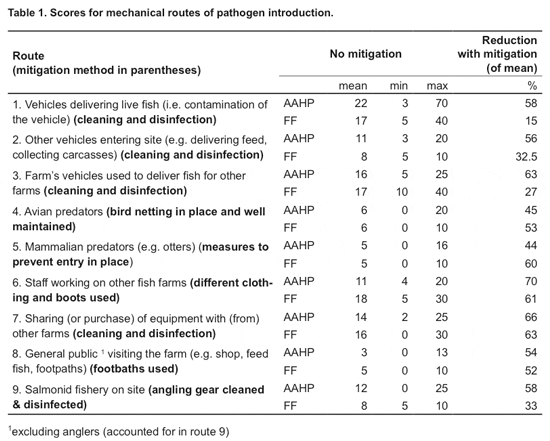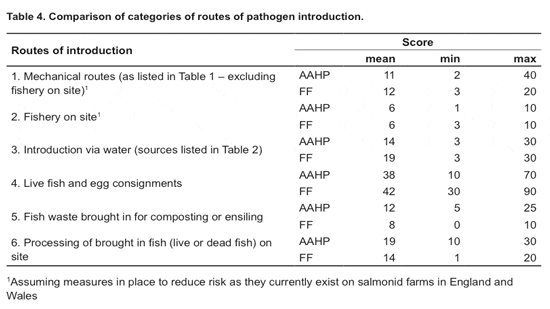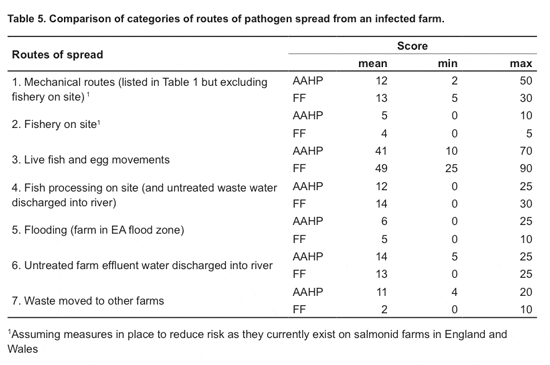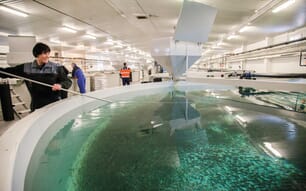The principle of RBS is that more resources are directed towards those zones, farms and species that are high risk (Stärk et al. 2006). This should ensure efficient use of resources whilst maximising the confidence in disease freedom generated by the outputs of the system.
To support a RBS scheme for notifiable fish pathogens in England and Wales, the Cefas Fish Health Inspectorate (FHI) has developed a risk ranking model based upon the most important routes of pathogen introduction and spread. The model includes the capacity to weight the different routes of introduction and spread for importance (see Oidtmann et al., accepted for publication).
However, as very little evidence exists on which to base the weighting, we adopted an approach previously used in aquatic animal health (Gustafson et al. 2005; Gustafson et al. 2010; VHSV Expert Panel and Working Group, 2010) and canvassed expert opinion.
For this exercise we consulted with fish farmers, vets and others providing animal health services to fish farmers. We used a questionnaire to gather expert opinion on the relative importance of routes for the spread of notifiable salmonid pathogens not present in the UK, i.e. viral haemorrhagic septicaemia virus (VHSV), infectious haematopoietic necrosis virus (IHNV) and Gyrodactylus salaris (Gs). The questionnaire was designed to focus on the spread of an exotic pathogen once established but before detection.
The questionnaire
The questionnaire was developed by Cefas epidemiologists in consultation with the FHI, to support selection of weightings in the fish farm risk ranking model. For the current study, routes were categorised: i) mechanical, ii) water-borne and iii) live fish and egg consignments.
The importance of routes within each category was assessed and then the categories were compared. Participants were asked to answer the questions using their understanding of current practices in salmonid farming in England and Wales. The scoring format was allocation of 100 points between the various routes under consideration to reflect their relative importance.
The importance of a route can be considered as having two elements. Firstly at a national level, how common is the route (e.g. the proportion of farms that buy in live fish). Secondly, if the route is present, the likelihood that it results in pathogen introduction. The questionnaire focused on the second part and it was made clear to participants that in their choice of scores they should assume that all farms are exposed via all routes (data on the presence or absence of routes for each farm has been collected during farm visits and from existing data).
Participants and respondents
The questionnaire was presented to a meeting of fish farmers at the AGM of the British Trout Association (BTA) with approximately 30 fish farmers in the audience. The questionnaire was also presented to a meeting of the FHI with 12 inspectors present.
Everyone at the meetings was given a copy of the questionnaire which was discussed question by question, and additional time was allowed for discussion. A third group of key researchers (both within and outside of Cefas), fish vets and other health advisors with a working knowledge of the UK salmonid industry - was approached directly and asked to complete the questionnaire electronically. Twenty-five consultees submitted responses which were classified into two groups:
- Aquatic animal health professionals (AAHPsn=20). This group included fish health inspectors, epidemiologists, disease experts and other staff working in aquatic animal health, from both within and outside Cefas. Experience ranged from three to 34 years, and four individuals stated previous fish farming experience.
- Fish Farmers (FFs, n= 5). Experience ranged from 10 to 36 years in the profession. The primary species farmed was rainbow trout (three out of the five) with brown trout also listed in three out of the five submissions. Brown trout production was mainly for restocking.
Pathogen Introduction: Mechanical Routes
Pathogens may enter a farm on various contaminated surfaces, i.e. on vehicles, animals, people and equipment (Table 1). The scores of the AAHPs and FFs groups were broadly similar.
Both groups considered vehicles delivering live fish and the farm’s own vehicles (used to transport fish) to be the most important routes; there was, however, a large variation in scores within both groups (indicated by the range between minimum and maximum scores). The AAHPs gave more weight to the presence of a fishery on site, whilst FFs more heavily weighted staff working on other sites.
Mechanical routes were scored twice: first as though there were no measures in place to reduce the risk; and secondly with risk mitigation measures (as currently practised in England and Wales). AAHPs considered that mitigation reduced risk by between 44 per cent and 70 per cent (depending on the route). FFs were more cautious about the impact of mitigation, especially cleaning and disinfection of vehicles (routes one to three) and angling gear (route nine).

Other important routes of mechanical introduction not covered by the questionnaire but mentioned by participants included boating and anglers’ equipment (which was included in the questionnaire only with respect to having a fishery on a fish farm). The main routes noted related to water sports.
Pathogen introduction: water routes
Pathogens may enter a farm via untreated river water if contaminated (Table 2). The average scores given by the two groups were very similar: both identified upstream farms and processing of fish upstream as the main routes, followed by stocking of hatchery reared fish. There was greater variation in the AAHP than FF scores, but this may be due to the greater number of respondents (20 versus five). The route where there was greatest variation in scoring was upstream farms holding susceptible species.
Pathogen introduction: live fish and egg consignments
Pathogens may enter a farm via a consignment of live fish or eggs (Table 3). Again the average scores from the two groups were very similar. A consignment of live fish was considered 2.5 to three times more likely to introduce a pathogen than undisinfected eggs, which were two to three times more likely to introduce a pathogen than disinfected eggs.
Comparison of categories of routes of introduction
The relative importance of the three categories of introduction route (i.e. mechanical, water, live consignments) were compared with two additional routes: introduction of fish waste from other farms for composting and ensiling; processing of bought-in fish (alive or dead) in close proximity to fish rearing units (Table 4; fishery on site was excluded from mechanical routes and scored separately).
Again the average scores from the AAHP and FF groups were very similar: introductions of live fish and eggs scored most highly (ca. 40 per cent), although there was a large variation. All other routes received mean scores of less than 20 per cent. Of the other routes, processing of fish for consumption and composting/ensiling of fish waste were given a slightly higher score by AAHPs than FFs.
Spread of pathogen after introduction and establishment on a farm
The routes by which a pathogen may be introduced to a farm, can also lead to spread from a farm (Table 5). The main difference between introduction and spread lies in the routes associated with water (c.f. Table 2). For pathogen spread, flooding was separated out and scored at the category level. Effluent from fish farming was scored separately to effluent from on-site fish processing.




Once again there was broad agreement across the AAHP and FF groups, with movements of live fish and eggs seen as the largest risks in pathogen spread, with fisheries and flooding the lowest. The main difference between the two groups was the scoring of movement of waste to other farms, which was given a higher score by AAHPs than FFs (11 per cent versus two per cent).
Differences in importance of routes between pathogens
The questionnaire was not pathogen specific. Participants were therefore asked, via a free text question, whether the importance of the routes of introduction and spread will be very different for haemorrhagic septicaemia virus (VHSV), infectious haematopoietic necrosis virus (IHNV) and Gyrodactylus salaris (Gs).
Fifteen of the 20 AAHPs considered that the importance of routes did vary between pathogens. Seventeen participants provided more information as free text:
- VHSV: AAHPs noted live fish movements and waste & processing as the two main routes of importance. FFs commented on live fish movements and that VHS will not survive on eggs. A general comment was that that VHS and IHN will have similar routes of importance.
- IHNV: The same routes were highlighted as for VHS, the only additions being that there is an increased risk with consignments of eggs.
- G. salaris (Gs) : Much more weight was placed on mechanical routes (including animal predators), water movements and the risks posed by fisheries and wild fish. It was noted that formalin treatment can be used to reduce the risk of introduction of Gs.
First introduction of exotic pathogens to the UK
A free text box was provided for participants to identify important routes for exotic pathogens to enter the UK, given biosecurity measures currently in place (e.g. live fish must come from countries or zones of equivalent or higher health status).
Twenty two of the 25 respondents provided information. A score for each route was calculated (rank one = three pts, rank two = two pts, rank three = one pt) and summed (Table 6). AAHPs and FFs scores were combined, so the results of this table reflect the AAHPs’ views (19 individuals) rather than the FFs (three individuals).
Illegally imported fish or eggs received most nominations and featured more in the Rank one category (eight mentions), demonstrating the general concern across AAHPs. Three FFs contributed information, but none listed illegal imports. The FFs main concerns were live fish and egg consignments, product processing and mechanical introductions (boats, etc). This could suggest the slightly wider view taken by the AAHPs with respect to future issues (such as epizootic ulcerative syndrome (EUS)), illegal imports, and the possibility of breakdowns in the surveillance operations of other states.
Additional comments
Space was provided for participants to make any additional comments which included:
- import of fish for processing from compartments with a lower heath status as an alternative route of pathogen introduction
- reliance on the efficacy of other countries regulators and the honesty of suppliers
- benefits of making the farm ranking results publicly available (farmers need to know the risk ranking of potential suppliers and other farms on the same watercourse)
- concerns about discharge of untreated fish processing waste into rivers
- support for focussing surveillance on sites most likely to spread pathogens
- concern that diagnostic capability and listing cannot keep pace with emergence of new diseases
- Biasing risk ranking towards fish movements
- Appreciation that better biosecurity will reduce the risk of disease whilst recognising the futility of individual measures, e.g. disinfecting a vehicle if the fish travelling in it are already infected
Conclusions
The exercise was to gather expert opinion on the likely importance of routes for the spread of exotic pathogens. Whilst the FFs had first- hand experience and knowledge of biosecurity on fish farms, the approach adopted required them to apply this information to a hypothetical situation (i.e. a pathogen has become established and is spreading undetected). It is possible that many participants did not feel well placed to make these abstract judgements.
AAHPs may be more comfortable speculating, based on their professional knowledge. Future expert elicitation exercises should be adapted to increase the level of participation of FFs and draw directly on their knowledge of diseases and the industry. Future exercises should also allow sufficient time for participants to complete the questionnaire during the session.
The key objective of the exercise was to generate an evidence base for weighting of routes in the farm risk ranking model applied by the FHI. It was reassuring that the responses of the AAHPs were in good agreement with those from the FFs. Thus we can use the pooled results of all participants to inform the model. There was agreement that vehicles entering the farm were the most important mechanical routes of transmission (three routes accounted for almost 50 per cent of the total score).
Contact with other farms via staff or equipment was also rated highly (especially by FFs). A key difference between the two groups was the effectiveness of mitigation measures, particularly disinfection of vehicles. It is possible that AAHPs judgements were based more on the theoretical reduction in contamination whilst FFs used their knowledge of current practices.
Water-borne introduction of pathogens via processing, wild fish upstream, and farms upstream with susceptible species were rated approximately equally and were allocated over 50 per cent of the total score. At the group level, routes which involved the introduction of fish (alive or dead) or fish waste (routes four to six) accounted for almost 70 per cent of the total score.
We did not attempt to capture uncertainty for each participant, partly because of the increased time that would have been required to complete the questionnaire. Ideally participants would be asked to give the most likely, highest and lowest plausible values, and additionally the probability that the true value of the figure lies within the interval created (Speirs-Bridge et al., 2010).
Our exercise only captured the variation between respondents. In a Delphi consultation, variation between participants can be reduced when scores are revised by each participant having seen aggregated responses. Uncertainty may result from true or stochastic variability or lack of knowledge; however these are difficult to separate (Vose, 2000). Stochastic variability is inherent in biological systems, and the importance of routes of spread will vary between outbreaks depending on the farm, river, season and chance events (e.g. mechanical transmission).
We recommend that the importance of the weighting for each route is further explored through sensitivity analysis. The output of the model is a risk score for each farm. These scores have no inherent meaning and can only be used to rank farms. Based on the farm ranking, farms are allocated a category (high, medium or low).
Sensitivity analysis would allow us to determine how the categorisation of farms near threshold values may change as the weighting of routes varies. Future research could be directed at evaluating the importance of routes for which the model is most sensitive.


